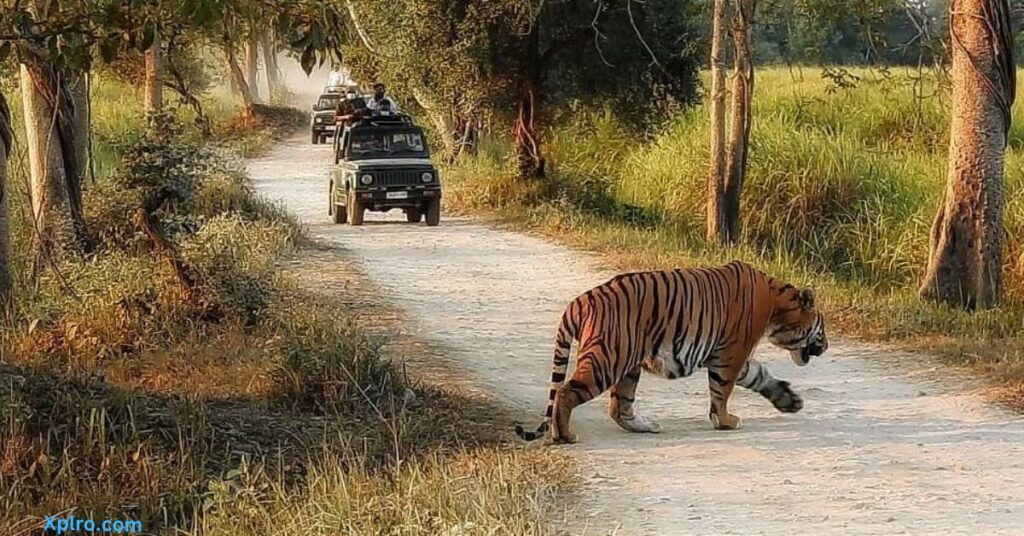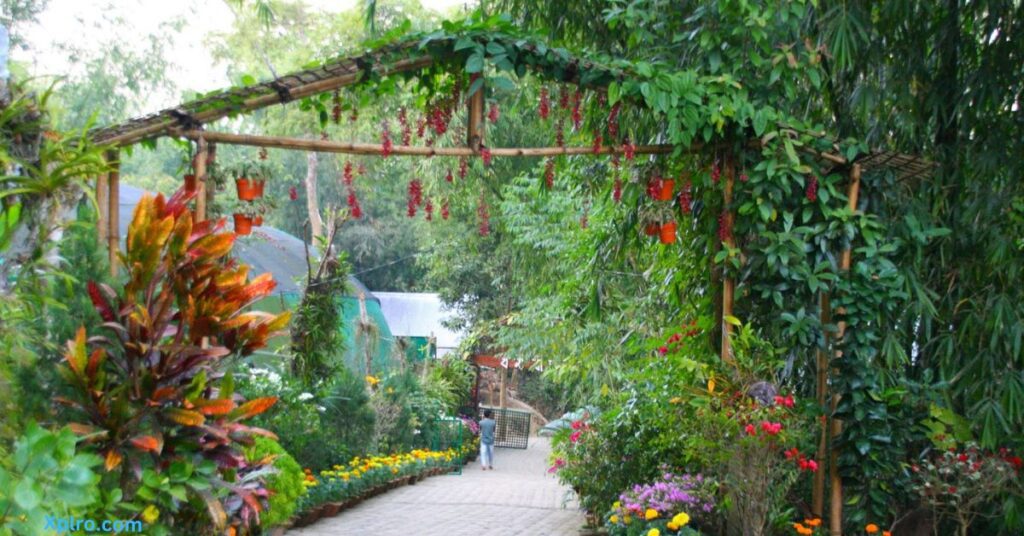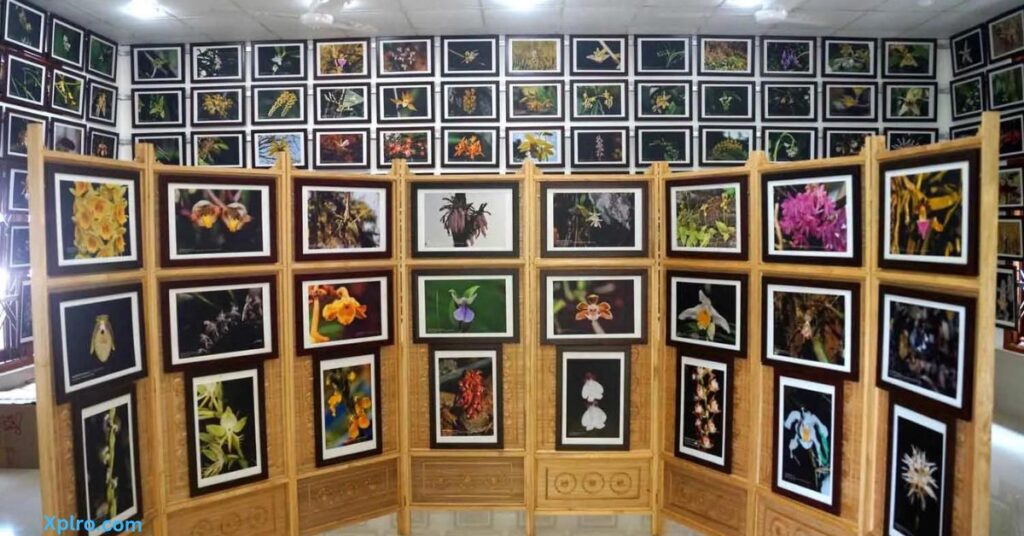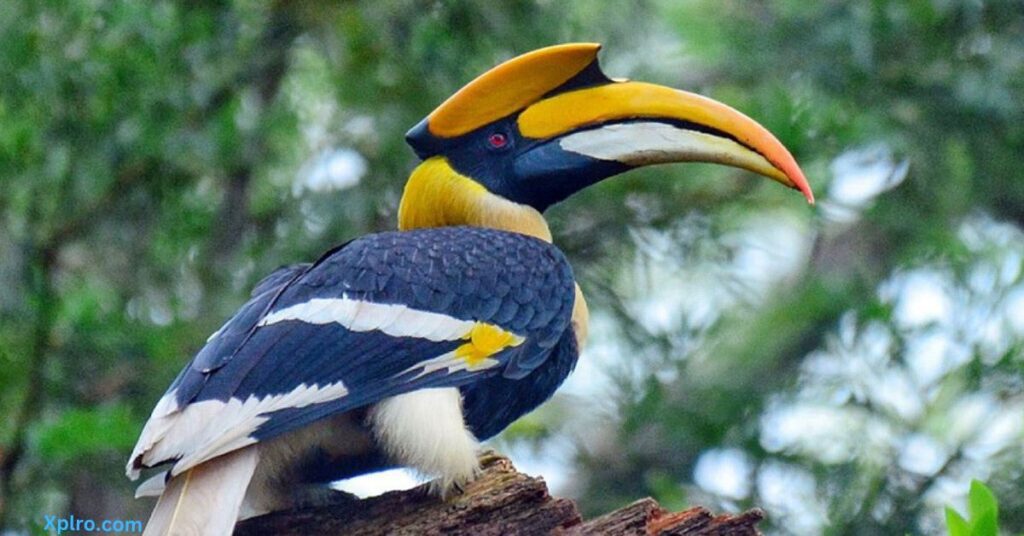Deep within Assam’s embrace lies Kaziranga National Park, a dazzling showcase of India’s unparalleled biodiversity. This crown jewel, designated a UNESCO World Heritage Site, sprawls across 430 square kilometers of pristine wilderness. Renowned as a sanctuary for the endangered Indian one-horned rhinoceros, Kaziranga unfolds like a captivating tapestry. Lush grasslands sway in the breeze, while dense forests and winding rivers carve a picturesque path through the landscape. This haven teems with an incredible array of wildlife, from the majestic Bengal tiger and the lumbering Asian elephant to a chorus of vibrant birdlife. Nature enthusiasts, adventure seekers, and wildlife photographers alike will find themselves captivated by the park’s untamed beauty.
How to reach:
Taking Flight:
Soaring closest to Kaziranga National Park is Jorhat Airport (JRH), roughly 97 kilometers away. This airport offers regular connections to major hubs like Guwahati, Kolkata, and Delhi. For a wider range of flights and destinations, Lokpriya Gopinath Bordoloi International Airport (GAU) in Guwahati is another option, although slightly further at 217 kilometers. Whichever airport you choose, taxis and pre-arranged shuttles await to whisk you to the park entrance.
Riding the Rails:
For a train adventure, Furkating Junction (FKG) beckons as the nearest railway station, boasting connections to Guwahati, Dibrugarh, and Kolkata, all around 75 kilometers distant. Guwahati Railway Station, a major railhead 240 kilometers away, offers connections to various parts of the country. From these stations, taxis or buses will ferry you comfortably to Kaziranga.
Hitting the Road:
Kaziranga National Park welcomes road trippers with ease. Buses, taxis, and private vehicles can navigate the well-connected routes.
From Guwahati: The park lies approximately 217 kilometers away. National Highway 37 (NH 37) offers a smooth journey, taking roughly 4-5 hours.
From Jorhat: A breezy 2-3 hour drive awaits via NH 37, covering the 97 kilometers between Jorhat and Kaziranga.
From Tezpur: Embark on a scenic 2-hour drive, traversing roughly 80 kilometers to reach Kaziranga from Tezpur.
Budget-Friendly Travels:
Assam State Transport Corporation (ASTC) and private operators cater to budget-conscious travelers with regular bus services connecting Guwahati, Jorhat, and Tezpur to Kaziranga National Park.
Best time to visit:
Winter Wonderland (November to February)
Kaziranga transforms into a wonderland during the winter months. With cool and pleasant weather, temperatures ranging from a crisp 5°C to a comfortable 25°C, it’s the prime time for wildlife sightings. Animals are drawn to the water sources and gather in the open grasslands, making them easier to spot. This is the season when jeep safaris reign supreme, offering excellent visibility for photography and unforgettable encounters with the park’s incredible creatures.
Spring Symphony (March to April)
As spring paints Kaziranga with warmth, the temperatures rise to a range of 15°C to 30°C, making it comfortable for outdoor adventures. While the wildlife sightings may not be quite as concentrated as in winter, animals are still frequently seen. This season boasts a vibrant symphony of migratory birds gracing the park, making it a paradise for birdwatchers.
Attractions:
Wildlife Safaris:

Kaziranga National Park pulsates with the thrill of the wild, offering an unparalleled glimpse into the heart of this UNESCO World Heritage Site. Divided into four distinct zones – Central, Western, Eastern, and Burapahar – each unveils a unique landscape teeming with life. Here, the iconic one-horned rhinoceros reigns supreme, but the wonders extend far beyond.
Embark on a jeep safari, guided by the watchful eyes of experienced naturalists. These journeys weave through the tapestry of Kaziranga’s diverse habitats, from the dense emerald embrace of the forests to the sun-dappled expanse of grasslands and the teeming wetlands.
Kaziranga National Orchid and Biodiversity Park:

Step into a vibrant celebration of the region’s floral and ecological tapestry at the Kaziranga National Orchid and Biodiversity Park. This haven boasts one of India’s most extensive collections of orchids, with over 500 species bursting forth in a kaleidoscope of colors and shapes. Lush grounds, meticulously maintained, invite you on an immersive journey through orchid-filled greenhouses and open-air gardens. Breathe in the delicate fragrance of these captivating blooms as you wander through their vibrant displays.
But Kaziranga’s beauty extends beyond orchids. Explore a haven for medicinal plants, each holding the secrets of ancient remedies.
Kaziranga National Park Museum:

Within the embrace of Kaziranga National Park lies a portal to its rich past and present – the Kaziranga National Park Museum. This museum transcends static displays, offering an immersive journey through the park’s captivating tapestry of nature and culture.
Step inside and delve into the park’s origins. Vivid dioramas and informative panels bring the story of Kaziranga’s diverse wildlife to life. Witness the mighty one-horned rhinoceros in its natural habitat, or come face-to-face (virtually, of course) with the elusive Bengal tiger. Look skyward and discover the symphony of birds that paint the Kaziranga skies with vibrant hues.
Birdwatching:

For bird enthusiasts, Kaziranga National Park is a song sung in feathers. With over 480 avian species flitting through its diverse ecosystems, the park is a paradise for those who appreciate the wonders of the winged world. From the verdant embrace of the wetlands to the sun-dappled grasslands and towering forests, Kaziranga provides a haven for a dazzling array of birds, both residents and those who migrate vast distances to find winter solace here.
Keen eyes might spot the majestic Great Indian Hornbill, its vibrant casque a beacon against the lush greenery. Soaring eagles, graceful storks, and a chorus of colorful songbirds paint the skies with life. A particularly thrilling sight is the endangered Bengal Florican, a reward for the patient birdwatcher.
Local Experiences:
- Traditional Weaving: Witness the magic of Assamese weaving firsthand. Learn about the intricate techniques and patterns as local artisans bring them to life on their handlooms. You might even get a chance to try your hand at it!
- Pottery Making: Unleash your inner artist in a pottery workshop. Mold clay into traditional items and create a unique souvenir to remember your trip.
- Handicrafts: Explore bustling markets and workshops, where skilled hands transform bamboo and cane into beautiful handicrafts.
- Folk Music and Dance: Immerse yourself in the vibrant culture with live performances of Bihu, a traditional Assamese art form featuring music and dance.
- Homestays: Experience local life firsthand by staying in a traditional Assamese home. Savor delicious home-cooked meals and learn about local customs.
- Tea Tasting: Embark on a journey to local tea plantations. Learn about the art of tea cultivation and indulge in a tasting session of freshly brewed Assam tea, a world-renowned delicacy.
- Cooking Classes: Join a local family in their kitchen and learn the secrets of preparing traditional Assamese dishes using fresh, local ingredients.
- Village Tours: Take a guided tour through nearby villages and observe the daily rhythms of rural life. Witness traditional agricultural practices and experience the warmth of the local community.
- Wildlife Conservation: Become a part of the solution! Learn about and contribute to local conservation efforts that protect the region’s precious wildlife and natural habitats.
- River Cruises: Glide along the majestic Brahmaputra River on a scenic boat ride. Enjoy breathtaking landscapes, spot a variety of birds, and soak in the tranquility of nature.
- Nature Walks: Lace up your boots and join a guided walk through the countryside. Discover the diverse flora and fauna of the region and learn about the traditional uses of medicinal plants.
- Cultural Festivals: Immerse yourself in the vibrant energy of local festivals like Bihu. Witness colorful celebrations, traditional attire, and experience the heart of Assamese culture.
Travel tips:
- Advance Bookings: Especially during peak season, lock in your accommodation and safari tours well in advance to avoid disappointment.
- Clothing: Pack light, breathable clothes for the day, with warmer layers for cooler mornings and evenings. Opt for neutral tones during safaris to blend in with the surroundings.
- Footwear: Sturdy, comfortable walking shoes are essential for navigating uneven terrain on safaris and nature walks.
- Sun Protection: Pack sunscreen, a hat, and sunglasses to shield yourself from the sun during outdoor activities.
- Insect Repellent: Don’t forget insect repellent, particularly for evenings, to ward off mosquito bites.
- Travel Documents: Keep your ID proof, travel documents, park entry permits, and safari bookings readily accessible.
- Local Guides: Consider hiring experienced local guides for safaris and nature walks. Their knowledge can significantly enhance your wildlife viewing experience.
- Respect Wildlife: Maintain a safe distance from animals, adhere to park rules, and avoid loud noises to ensure a safe and respectful wildlife encounter.
- Binoculars and Camera: Pack binoculars for birdwatching and a good camera with a zoom lens to capture those unforgettable wildlife moments.
- Health Precautions: Carry a basic first-aid kit and any personal medications you might need. Stay hydrated throughout the day, and be cautious with food and water consumption to avoid illness.
- Cash: ATMs and card payment options might be limited in remote areas, so carry sufficient cash for any eventualities.
- Local Culture: Be mindful of local customs and traditions. Engage with the communities with an open mind and learn about their rich culture.
- Eco-Friendly Practices: Minimize your plastic footprint, dispose of waste responsibly, and consider supporting local conservation efforts to ensure a sustainable travel experience.
Conclusion
India’s pride, Kaziranga National Park, shines on Xplro.com as a haven for wildlife enthusiasts, birdwatchers, and culture seekers alike. Diverse ecosystems, from lush forests to sprawling grasslands, shelter the iconic one-horned rhinoceros and the magnificent Bengal tiger. Witness these wonders on thrilling safaris, delve into the vibrant Orchid Park, or explore the whispers of history at the Deoparbat Ruins. Engage with local communities and explore nearby villages for a richer cultural connection. Kaziranga promises an unforgettable adventure, leaving you awestruck by nature’s delicate balance and the tireless efforts to conserve it. Let Xplro.com be your guide to unlocking the magic of Kaziranga National Park.
FAQs
Where is Kaziranga National Park located?
- Kaziranga National Park is situated in the northeastern state of Assam, India.
What makes Kaziranga National Park unique?
- Kaziranga is renowned for its population of the Indian one-horned rhinoceros, as well as being a UNESCO World Heritage Site due to its exceptional biodiversity.
What wildlife can visitors expect to see in Kaziranga National Park?
- In addition to the one-horned rhinoceros, Kaziranga is home to tigers, elephants, wild water buffalo, swamp deer, and numerous bird species, including migratory birds.
When is the best time to visit Kaziranga National Park?
- The best time to visit Kaziranga is from November to April when the weather is pleasant and wildlife sightings are at their peak.
What types of safaris are available in Kaziranga National Park?
- Visitors can enjoy jeep safaris and elephant safaris in Kaziranga, offering opportunities to explore the park’s diverse landscapes and observe wildlife up close.
How can travelers reach Kaziranga National Park?
- Kaziranga is accessible by road from Guwahati, approximately 200 km away, which has the nearest major airport and railway station.
What accommodation options are available within Kaziranga National Park?
- Accommodation options in Kaziranga include eco-lodges, resorts, and forest rest houses, catering to various budgets and preferences.
What are the entry fees for Kaziranga National Park?
- Entry fees vary for Indian and foreign visitors, with additional charges for safaris. It is advisable to check current rates before planning your visit.
What should visitors pack for a trip to Kaziranga National Park?
- Essential items to pack include light, breathable clothing suitable for safaris, sturdy walking shoes, binoculars, a camera with a zoom lens, sunscreen, and insect repellent.
What eco-friendly practices should travelers follow in Kaziranga National Park?
- To promote eco-friendly tourism, visitors should respect wildlife and habitats, minimize plastic usage, stay on designated trails, and support local conservation efforts.
Are walking safaris allowed in Kaziranga National Park?
- Walking safaris are restricted in the core zones of Kaziranga due to safety concerns. However, guided nature walks are available in designated areas.
What are some nearby attractions to explore near Kaziranga National Park?
- Nearby attractions include the Kaziranga Orchid and Biodiversity Park, Deoparbat Ruins with historical significance, and opportunities to experience local Assamese culture in surrounding villages.






